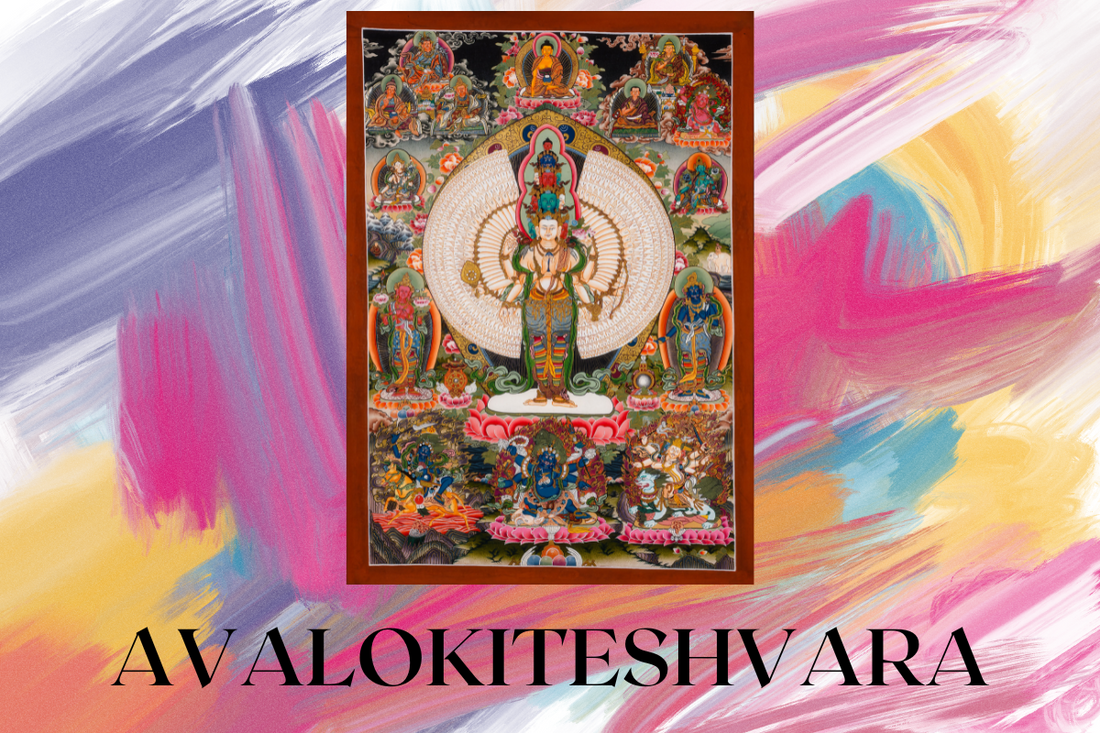
Avalokiteshvara: The Bodhisattva of Compassion
Share
Did you know Avalokiteshvara is revered across Asia under different names—Guanyin in China, Chenrezig in Tibet, and Kannon in Japan?
As the embodiment of mercy and boundless love, Avalokiteshvara inspires millions to walk the path of kindness and selflessness.
In this article guide, let's explore the stories, symbolism, and spiritual significance of Avalokiteshvara, the ultimate guardian of compassion!
Who is Avalokiteshvara?
The name "Avalokiteshvara" is rich in meaning – "Avalokita" translates to "one who observes," and "Ishvara" means "lord" or "master." Put together, it becomes "The Lord Who Looks Down with Compassion," reflecting the Bodhisattva's unwavering attention to the suffering of all beings.
Avalokiteshvara (Sanskrit: अवलोकितेश्वर) is one of the most cherished figures in Buddhism, symbolizing the purest form of compassion that all Buddhas embody. Known as Guanyin in Chinese Buddhism, Chenrezig in Tibetan, and Kannon in Japan, this enlightened being represents the core of universal compassion and loving-kindness. Often depicted as a manifestation of Amitabha Buddha, he bridges the connection between the historical Buddha, Gautama, and the future Buddha, Maitreya.
But Avalokiteshvara's influence stretches beyond Buddhism. He's sometimes linked to Hindu deities like Shiva and Vishnu, and his compassionate nature has made him a key figure in many cultural contexts throughout Asia. His worship spans not only Buddhist practices but also local folk religions, emphasizing his universal appeal.
Avalokiteshvara's Two-Armed Form
Avalokiteshvara’s two-armed form is a beautiful and meaningful representation, one that speaks directly to the heart. This simpler, earlier depiction of the Bodhisattva emerged in the 1st century CE with the rise of Mahayana Buddhism in India. Known by names like Khasarpani and Padmapani, each one highlights a unique facet of his compassionate essence, making this form a true symbol of universal care and kindness.
Symbolism
In his two-armed form, Avalokiteshvara often stands or sits with a peaceful, serene expression that instantly calms the soul. In one hand, he holds a lotus flower – a symbol of spiritual awakening and the purity that arises from suffering. His other hand typically forms the varada mudra, the gesture of giving, symbolizing his generous bestowing of compassion and blessings to all living beings.
Significance
What makes this form so special is its simplicity – no extra arms or heads, just two hands representing the essential qualities of wisdom and compassion, the cornerstones of Buddhist practice. For many, this portrayal is more approachable, making it a perfect focus for meditation and devotion. It’s a reminder that in the heart of simplicity lies the purest form of spiritual connection.
The Thousand-armed Avalokiteshvara

The Thousand-Armed Avalokiteshvara, or Chenrezig in Tibetan Buddhism, is one of the most prominent and deeply revered forms of this Bodhisattva. This powerful representation emerged as Mahayana Buddhism evolved, symbolizing an expansive understanding of the boundless reach of compassion. The Thousand-Armed form (Sahasrabhuja-Sahasranetra) is not just about numbers; it’s about infinite possibilities of compassion in action.
Symbolism
The Thousand-Armed Avalokiteshvara is usually shown with eleven heads and a thousand arms, each representing a unique aspect of his immense compassion. The central hands are often in prayer, holding a wish-fulfilling jewel, while other hands hold sacred symbols like the lotus, the wheel of Dharma, a bow and arrow, and a vase.
But the most striking feature? Each of his thousand arms is adorned with an eye in the palm, signifying his omniscience – his ability to see and respond to the needs of every living being, all at once.
Significance
The eleven heads represent the many facets of compassion Avalokiteshvara embodies, including both peaceful and wrathful forms, showing that compassion isn’t always soft; sometimes, it’s fierce in confronting challenges, yet always rooted in love and care. This form’s significance lies in its sheer scope – a reminder that compassion is limitless, able to manifest in countless ways to meet the needs of all beings.
A famous legend tells of how Avalokiteshvara’s head shattered as he wept over the suffering in the world. Amitabha Buddha then granted him more heads and arms to amplify his ability to help others. This story reflects the Bodhisattva’s ultimate role as a protector, continuously extending his arms to shield beings from life’s dangers and adversities.
Avalokitesvara's Four-armed Form
Avalokiteshvara’s Four-Armed Form is an incredibly powerful and meaningful representation of the Bodhisattva, often referred to as Chenrezig in Tibetan Buddhism. This four-armed depiction is a beautiful bridge between the simplicity of the two-armed form and the grandeur of the thousand-armed one. It symbolizes a more accessible yet profound manifestation of compassion and mercy. Often seen in triads with other key figures like Manjushri (wisdom) and Vajrapani (power), together, they embody the essential qualities necessary for enlightenment.
Typically shown as a serene white figure, Avalokiteshvara’s Four-Armed Form radiates purity and compassion. He is often seated in a vajra posture, cross-legged on a lotus flower – a symbol of spiritual awakening and the blossoming of enlightenment. The four arms are a reflection of the Four Immeasurables: loving-kindness, compassion, sympathetic joy, and equanimity. Each pair of arms is imbued with its own meaning:
The upper hands are pressed together in prayer (anjali mudra), symbolizing Avalokiteshvara’s vow to protect all beings.
One upper hand holds a wish-fulfilling jewel (mani gem), representing his power to grant wishes and fulfill the needs of all.
The lower right hand holds a crystal rosary (mala), symbolizing meditation and recitation to free beings from the cycle of samsara.
The lower left hand holds a white lotus, symbolizing purity and the potential for spiritual growth.
This form emphasizes the balanced practice of meditation, wisdom, compassion, and skillful means. It's especially prominent in Tibetan Buddhism, where it's closely associated with meditation practices and initiations. Avalokiteshvara’s four arms beautifully reflect the Four Immeasurables, the heart of his mission: to help all sentient beings transcend suffering through love, kindness, and wisdom.
His posture and attributes express a deep commitment to active compassion. Every detail serves as a reminder of his unwavering dedication to guiding others towards liberation, using the perfect balance of compassion and wisdom.
Avalokiteshvara as a Bodhisattva
Avalokiteshvara as a Bodhisattva is the very embodiment of the Mahayana path, demonstrating a profound commitment to helping all beings achieve liberation. His journey isn’t just about attaining enlightenment for himself – it’s about postponing his own final enlightenment until every sentient being has been freed from suffering. Here’s how this selfless dedication manifests in his essence:
1. The Bodhisattva Vow:
At the heart of Avalokiteshvara’s being is his vow to liberate all beings. His promise to delay his own enlightenment until every single sentient being reaches liberation underscores the depth of his compassion and altruism. This vow is a cornerstone of Mahayana Buddhism, emphasizing that the true path to enlightenment is through selfless service to others.
2. Universal Accessibility:
Avalokiteshvara isn’t just a figure for the spiritually advanced – he’s available to anyone who calls upon his name, regardless of their background or level of practice. His boundless compassion makes him accessible to all who are in need of comfort, healing, and guidance.
3. Skillful Means:
A key quality of Avalokiteshvara is his ability to manifest in whatever form is most helpful for the suffering beings he’s trying to assist. Whether as a compassionate teacher, a gentle guide, or a fierce protector, he adapts to the unique needs of every individual, always finding the best way to ease their suffering.
4. Active Compassion:
Avalokiteshvara’s compassion is not passive – it’s a dynamic, active force. He doesn’t simply feel for the suffering of others; he works tirelessly to alleviate it. His actions, filled with wisdom and love, embody the true essence of compassionate engagement.
In these ways, Avalokiteshvara as a Bodhisattva teaches us that true compassion is not just about feeling for others – it’s about stepping into action, embodying wisdom, and committing ourselves to the liberation of all beings.
Avalokiteshvara Mantra
The mantra "Om Mani Padme Hum" is perhaps the most well-known and beloved chant associated with Avalokiteshvara. This six-syllable mantra is a powerful tool for transformation and spiritual growth. Each syllable carries deep meaning, guiding practitioners on the path to compassion, wisdom, and enlightenment:
- Om: Represents the practitioner’s impure body, speech, and mind, which can be transformed into the pure, exalted body, speech, and mind of a Buddha.
- Ma: Symbolizes the path of ethics and the desire to overcome attachment, reminding us to cultivate moral conduct.
- Ni: Represents patience, encouraging us to conquer anger and hatred with calm and tolerance.
- Pad: Stands for diligence, urging us to abandon laziness and persist on the spiritual path.
- Me: Represents concentration, helping us overcome scattered thoughts and sharpen our focus.
- Hum: Symbolizes wisdom, representing the defeat of ignorance and the awakening of profound understanding.
By reciting this mantra and meditating with Chenrezig thangka practitioners seek to purify their negative karma and cultivate both compassion and wisdom, ultimately striving to mirror Avalokiteshvara's boundless love and care for all beings.
Frequently Asked Questions
What is the difference between Avalokiteshvara and Guanyin?
Avalokiteshvara and Guanyin are essentially the same deity. Guanyin is the Chinese manifestation of Avalokiteshvara, often depicted in a feminine form, reflecting cultural interpretations across different regions.
Why does Avalokiteshvara have multiple arms?
The many arms symbolize Avalokiteshvara’s capacity to help countless beings at once. Each arm represents different ways of offering guidance and teachings, showing that compassion has limitless forms.
Is Avalokiteshvara male or female?
Avalokiteshvara transcends gender. Depending on the culture and context, the Bodhisattva can appear in either male or female form, always adapting to what best serves beings in need.
What is the best way to practice devotion to Avalokiteshvara?
Devotion to Avalokiteshvara is cultivated through practices like regular mantra recitation, meditation focused on compassion, and actively helping others. These practices help you connect deeply with the Bodhisattva’s energy.
Why is Avalokiteshvara considered the Bodhisattva of Compassion?
Avalokiteshvara earned this title because of the Bodhisattva’s unwavering dedication to alleviating suffering. His boundless compassion is exemplified by the vow to not attain enlightenment until all beings are liberated from suffering.
Conclusion
At Fine Thanka Art, we are proud to be the leading Thangka sellers in Nepal, offering authentic Tibetan Thangka paintings that are crafted with love, skill, and profound spiritual meaning. Our exquisite collection includes the highly revered Chenrezig and Avalokiteshvara Thangka, each designed to resonate deeply with your spirit.
Click on Add to Cart button now to bring this beautiful Avalokiteshvara Thangka into your space. Or, visit our store in Thamel to experience these masterpieces in person, we guarantee you'll find the perfect Thangka to elevate your space.
